Cuteness is intrinsically playful. It invites us to become childlike again, offering respite from the pressures and anxieties of everyday life. It creates a space of comfort and kindness, encouraging a sense of belonging and community. The internet provides a natural home for such engagement and has allowed cuteness to become a powerful tool in recalibrating contemporary subjectivities. Yet, ironically, by keeping us in thrall to our smart devices, cuteness may also be strengthening our ties to the power structures that cause us to seek its comforts in the first place.
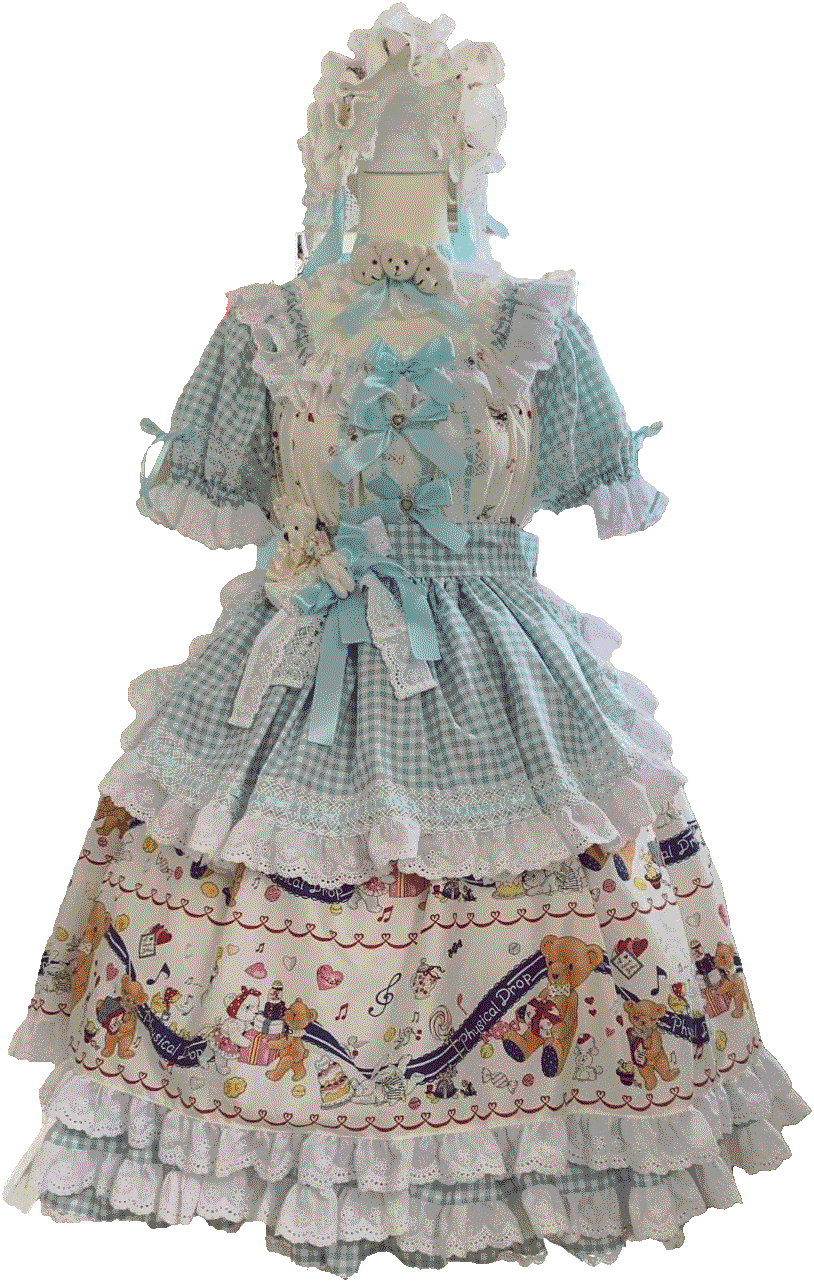
1
Happy Bear Parade
2023
Kuniko Kato of PhysicalDrop (Tawaraya—KATO)
Dress
Lolita fashion combines kawaii fashion and a gothic and punk sensibility to create a ‘hyper-femme’ space for people of all genders. With a 40-year history in Japan, lolitas are well known for their ferocious independence, expressed by the sheer excess of their garments which take up considerable space in compact urban cities . This outfit has been designed for this exhibition by Kuniko Kato, a lolita who has been in the scene since the 1990s, and whose online diary became a sensation in the subcultural scene in Japan during the beginnings of internet forums and blogging. Kato has also made significant contributions to the design and aesthetics of lolita fashion, having founded the label Metamorphose Temps de File, and then departing in 2009 to open her independent label PhysicalDrop (Tawaraya-KATO). Responding to the exhibitions theme of cute, Kato has sought to express the excessive girlish of lolita by combining all the stylistic features seen in the subcultures garment design over the decades. They all appear here in a cacophony of frills, in particular the ‘apron skirt’, ‘bustle’, ‘half bonnet’ and ‘choker’, as they are called in lolita jargon . Lolita is not to be confused with Vladimir Nabakov’s (1955) novel of the same name. In Japanese, the word has a range of usages and meanings, and in this context has a 60-year history in girls culture as a term to describe girlish fashion with an excess of ruffles. Researcher Masafumi Monden has also highlighted the key role that girls manga has played in shaping the princessy aesthetics of lolita fashion, as well as the ‘musume’ costuming of Takarazuka. During lolita fashion’s birth in the late 80s, rock and punk musicians like Lolita Junko and Jun Togawa took up the name ‘lolita’ and its frilly veneer; shrieking, smashing and screaming, these performers upended and railed against the idea of ‘proper behaviour’ for young women. From this history comes the ideology of lolita, which novelist Novala Takemoto describes as a figurative dagger hidden behind practitioners’ skirts. While lolitas today may appear sweet and princessy, lolitas are fiercely independent and unafraid to speak up to protect their friends. Lolita has become a global subcultural movement, with each country having its own take and ideology on what the fashion means. A key communicative feature of lolita fashion is its textile prints; designers lovingly craft complex imagery, motifs and graphic storytelling that is displayed along the skirts of many lolita garments. Lolitas choose prints whose concepts and stories resonate with their own idea of kawaii, and these garments are highly collectible due to their limited print run. This outfit, named Happy Bear Parade depicts a range of animal friends marching together. Each animal is unique and has been lovingly drawn by Kato. Kato takes inspiration from traditional British picture book illustrations of toys but has also incorporated her own twist: a turtle, her favourite animal.
words by Dr Megan Catherine Rose

2
Djungelskog
2019
Ikea
Toy bear
This big brown bear's inflated stomach, drooping head, soft fur, and dopey expression guarantee a loveable cuddly toy. Djunkelskog is at once oversized and thoroughly unthreatening. First sold by IKEA in 2019, he reached new heights of internet fame in 2020, with countless social media users declaring their love for his comforting embrace, and staging photos with the metre-tall bear. In the midst of a pandemic, there was, and perhaps still is, something reliably cute about Djunkelskog, a soft and sizeable companion, but also a soothing and ever-present listener.
words by Vaishna Surjid
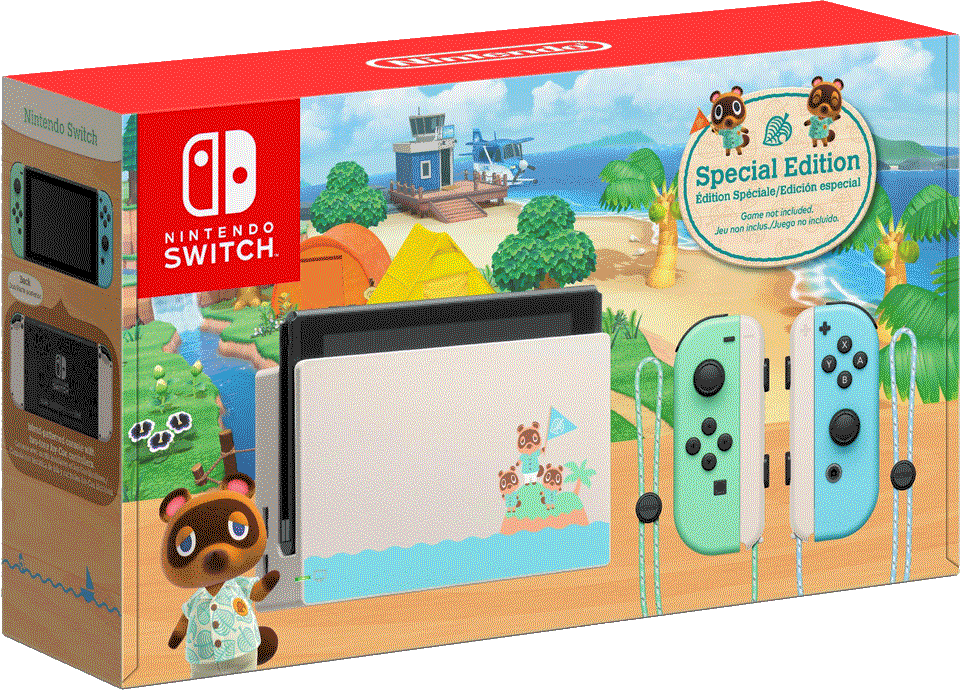
3
Animal Crossing: New Horizons
2020
Nintendo
video game and merchandise
Released for the Nintendo Switch in March 2020, Animal Crossing: New Horizons provided an imaginary world of escape and resilience when the world needed it the most. Its playful aesthetics, and relaxing island setting and population of neighbourly critters became a mental health lifesaver for players around the globe while in lockdown during the initial COVID-19 outbreaks. Erica Kanesaka observes that through the game world of New Horizons, we were able to dream of an alternative world centered around collective safety and care at a time full of uncertainty and fear. By the end of 2020, Nintendo reported 26.04 million sales, making New Horizons a smash hit amongst its titles, and far outselling previous games in the series. New Horizons is part of a long-standing franchise; the first Animal Crossing game was released in 14 April 2001 for the Nintendo 64 in Japan, and internationally 2002-2006. Developed by Katsuya Eguchi and Hisashi Nogami, this game was originally targeted at young teens, but quickly became a fan favourite among adults as well. In particular, these older players were drawn to the game's soothing qualities as a way of destressing and practicing mindfulness. Animal Crossing’s design has its own ‘iyashi’ (restorative) potential through its slow and relaxing pace, similar to the calming environment experienced in cat cafes.
words by Dr Megan Catherine Rose
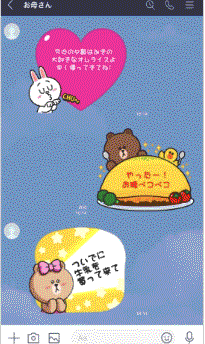
4
Line Friends
2015
Line Friends Corporation
Mobile messenger stickers
LINE FRIENDS is a media franchise of LINE, an instant messaging app popular in Asia, released in 2011 by Naver, a South Korean search engine giant. The app’s popularity can be attributed to its innovative feature, LINE Stickers, which function as large emojis using cartoon characters with caricature depictions, enriching the variety of expressions users can convey and allowing them to communicate complex feelings with few to no words. The first batch of LINE FRIENDS included original characters designed by Korean illustrator Kang Byeong Mok (Mogi). The humorous, exaggerating expressions of the characters proved to be so successful that other messengers, such as WhatsApp, quickly developed their own stickers. While the popularity of stickers reflects an ever-accelerating pace of modern life, their light-hearted tone has developed a new style of communication and elevated casual daily conversations. Users can also gift each other stickers as a new way of bonding.
words by William Seung

5
Poo-Chi
2000
Sega
Robot dog
Poo-Chi was released in the 2000s by Sega in collaboration with Tiger and designed by Samuel James Loyd and Max Lucas as one of the first play line robot dog toys. This pocket-sized pup embodies Y2K era cute aesthetics, coming in a variety of vibrant colours, utilising internet-style emoticons to communicate and singing and dancing in uncanny ways. Poo-Chi was part of a wave of other virtual creatures, from Neopets to Tamagotchis.The birth of Poo-Chi coincided with the debut of Sony’s AIBO, a robot dog who brought in the new millennium with the promise of artificial companionship and robotic innovation. Poo-Chi, targeted towards children for a fraction of the price, resonated with this potential and became a smash hit toy. In its initial commercials, children are shown ‘inventing’ the technology in makeshift garage science labs. Cute technology of the new millennium captured the imaginations of children with what researcher Anne Allison describes as the promise of portable intimacy and play. At the time of its release, there was great anxiety that electronic pets might erode children’s capacity to care and connect with animals and each other. However, like all animatronics, this toy relies on the imagination through what Terry Silvio would describe as a diffusion of agency between puppet and human. Robot dogs have long existed as fictional companions in sci-fi, such as Doctor Who’s K9. As a hybrid of geometric, zoomorphic and cartoon morphologies, Poo-Chi leapt from the television screens and imaginations of children and into their hearts and lives. While some report losing interest in their Poo-Chis once its novelty wore off, others still today recall with great nostalgia the world they co-created with their cyberpet up until the day it let out its last tuneful yip.
words by Dr Megan Catherine Rose
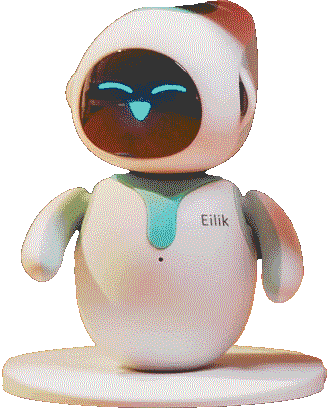
6
Eilik
2021
Energize Lab
Robot
Eilik, developed by Shaw Yeung at Energise Lab, was brought to life by a crowdfunding initiative on Kickstarter in 2021. Designed as a cute desktop companion, Eliki is tasked with keeping workers happy and engaged while working on their computer. As a social robot, Eliki provides emotional support and entertainment that is both dynamic and responsive to its environment. It invites touch and play through a range of activities and games. Described as ‘tech with heart’, this pocket-sized robot is inspired by on-screen robo-companions like R2-D2 and Baymax. Eilik takes on a number of key strategies found in ‘cute engineering’, led by researchers like Michiko Ohkura, who identify, isolate and exaggerate key aspects of cuteness. Through taking on cute morphologies, robots are able to both emote and communicate in ways that can be clearly understood by the user as ‘positive’ and ‘warm’, and culturally codes it as an object of affection. In his survey of machine cuteness, researcher Joel Gn highlights the key role of smallness, minimal smooth exteriors and the abstracted humanoid form as some of these key strategies, which we can see reflected in Eilik’s design. Its cutesified interactivity also invites play and care; Eilik’s ‘emotion engine’ simulates different moods and influences its animations and responses according to how it is treated over time, so as to evoke a sense of subjectivity and sensitivity. Eilik’s fear of heights and vibrations is also intended to encourage tenderness and care from its human companion.
words by Dr Megan Catherine Rose
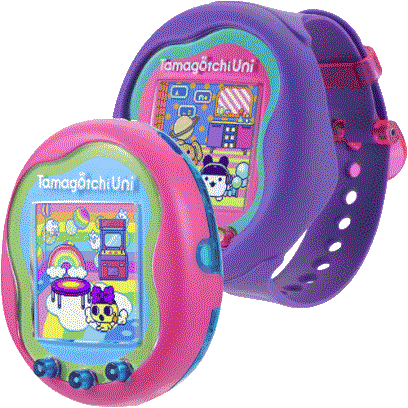
7
Tamagotchi
1997
Courtesy Bandai
Virtual pet
First released in 1996, Tamagotchi is a digital pet stimulation game that comes with its own portable egg-shaped device. Owners are required to play with their pets, feed them and clean their room in order to keep the pets happy and alive. The simplistic but addictive mechanism, paired with the cute but alien-like pixelated character design, quickly sparked a worldwide craze, with children and teenagers begging their parents to buy them one (or more). Public opinion was often divided. On one hand, some criticised Tamagotchi for causing disruption to classroom teaching and other activities; on the other hand, some suggested it could teach children about pet ownership and responsibility. Although the initial fanatical Tamagotchi boom did not last long, the franchise continues to grow and develop newer versions, adding more colours and functions while maintaining its core handheld petkeeping system. Tamagotchi, the first game to achieve such popularity, exemplifies how our attachment to cuteness and our desire to care for other beings, even if they are digital, can begin at an early age.
words by William Seung
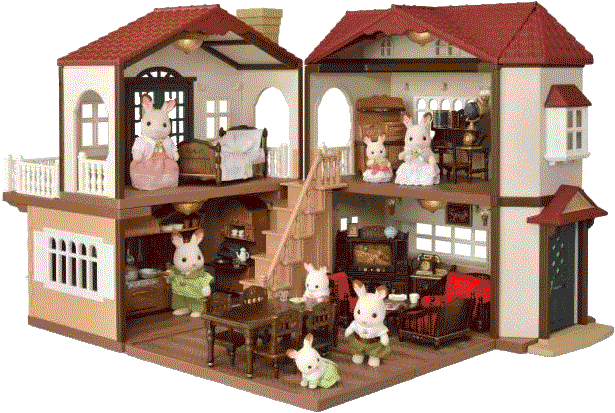
8
Sylvanian Families
2019
Courtesy Epoch
Play set
Sylvanian Families is a renowned dollhouse franchise by the Japanese toy-making company Epoch. First released in 1985, it soon reached global recognition and became a household name with its traditional-looking rural English houses and anthropomorphic fuzzily flocked animal play figures, all of whom come with a story, personality and occupation. Stemmed from the word ‘sylvan’, meaning ‘of the forest’, the world of Sylvanian Families, originally named Pleasant Animals of the Forest Epoch Family System, is set to take place in the ‘Great Nature’. The overall design concept of a romanticised, upper-middle class European rural fantasy world filled with animal families surrounding by nature has been consistent since its first launch. While the Sylvanian Families originally targeted children, it has gathered a following across all age groups with serious adult collectors and fans, often rekindling treasured childhood memories and sharing their passion through various subcultural communities across the globe. During the COVID-19 lockdown the brand experienced a surge in demand for its products. Its lasting popularity is perhaps a reaction to our intensely urbanised and technology-centric everyday lives, showing not only a nostalgic yearning for an idyllic and innocent, albeit fantasised, rural lifestyle, but also for the love and care found within an idealised extended family.
words by William Seung

9
My Little Pony: Friendship is Magic
2010
Hasbro
Vinyl figures
One example of a cuteness-orientated online fan community is the ‘Bronies’, a fan group based around the adoration of the animated US TV programme My Little Pony: Friendship is Magic, first aired in 2010. Perhaps unexpectedly, this community is largely made up of adult men who have come together to consciously redefine their masculinity through their shared love of the show. The name ‘Bronies’ is thought to be a portmanteau of ‘bro’ and ‘pony’, though the name could also come from the place where the community started – on the internet chat forum 4Chan’s ‘b’ message boards. As well as feed threads on 4Chan, Bronies are known for their pony art, original pony-themed songs, fan videos posted on YouTube, and meet-ups in large conventions often involving cosplay. An ongoing sociological study of this fandom interviewed 60,000 fans and found that ‘life guidance’ was the thing that fans most valued from the show, while almost two thirds of Bronies reported improvements to their relationships as a result of becoming part of the community.
words by Claire Catterall
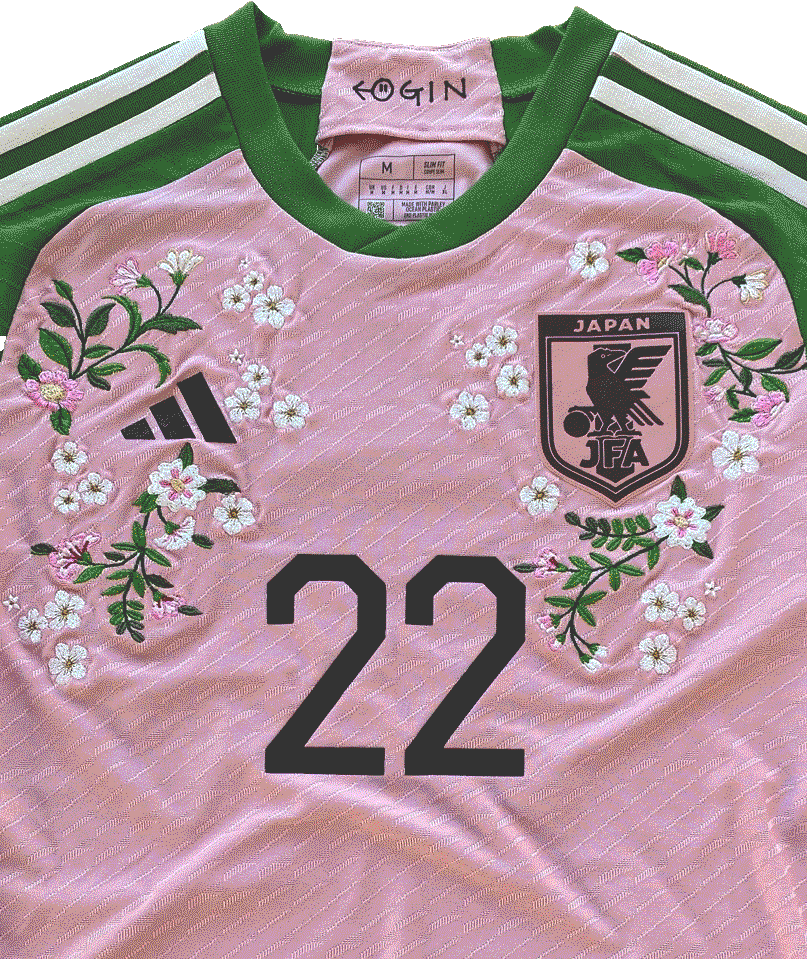
10
Custom embroidered football shirt
2023
Diana Al Shammari
Football shirt
The football shirt, once only worn by die-hard fans representing their teams, is now a fashionable item for anyone, regardless of their sporting allegiances. A cornerstone of the 'blokecore' trend, football jerseys have graced Balenciaga and Wales Bonner runway shows and been worn by celebrities including Kim Kardashian and Bella Hadid in recent years. At one point, many might have associated the football shirt with the excess and violence of hooliganism; now, it is for everyone. California-based designer Diana Al Shammari, known by many as The Football Gal, creates custom-embroidered jerseys featuring floral patterns, softening their aesthetic and throwing into question any macho associations they might have. For Shammari, the football shirt is a symbol of togetherness; as she told Versus, it ‘isn’t just for footballers on the pitch, it’s also for the fans and it represents a club’s culture, history, and personality.’
words by Phin Jennings
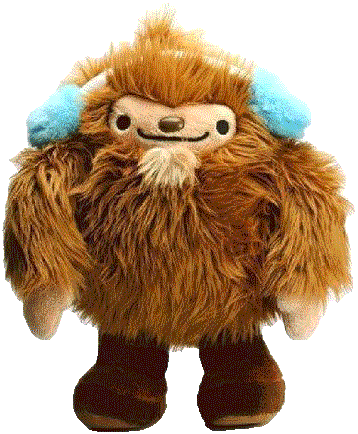
11
Quatchi, Vancouver Olymics mascot
2010
Meomi Design
Plushie
Quatchi was one of the mascots for the 2010 Winter Olympics in Vancouver, Canada. Quatchi’s design is based on the Sasquatch, sometimes known as Bigfoot, a large, hair-covered and ape-like mythical creature thought to have originated in the Pacific Northwest and is a popular figure in British Columbia. He was the winning design of an open call competition won by Meomi Design, with their proposal based on local folklore and culture. Although rarely associated with happiness, this local legend was transformed into a cuddly and harmless character, cheering athletes and viewers with sheer joy. The mascots not only represented the host but also the Olympics’ festive atmosphere and its spirit of advocating kinship amongst people from different cultures and backgrounds through sports.
words by William Seung
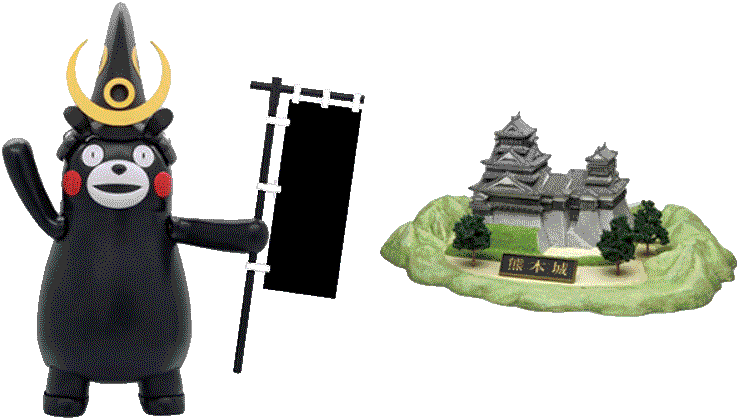
12
Kumamon, Kumamoto Prefecture's mascot
2017
Fujimi Mokei
Vinyl figure
Kumamoto is a prefecture, or government district, in Japan dominated by rural agriculture and forestry. To make it a more appealing destination for tourists, its governing body devised a marketing campaign featuring a cute bear-like boy covered in black fur called Kumamon. Launched to coincide with the opening of a new railway connecting Kumamato to Osaka, Kumanon quickly became a sensation; his clumsy but endearing performance and lovable appearance gaining millions of fans both in Japan and abroad and putting Kumamato firmly on the map. Kumamon is one of numerous yuru-chara in Japan and undoubtedly the most well-known. Coined by Jun Miura, an illustrator and pop culture critic, yuru-chara is a term that describes a certain type of mascot character in Japan that represents a region, event or organisation. Miura stated that a yuru-chara must convey a strong message of love for a local region or community, it must exhibit unique and clumsy behaviour; and it must be yurui (meaning unsophisticated or laid-back) and lovable. These three criteria distinguish them from mascots of commercial products and sports teams. Today, there are thousands of yuru-chara promote a multitude of entities, ranging from a prefecture to a street. This propensity may link back to Japanese ancient polytheism and folklore, which reflect an emotional, empathetic bonding with non-human things and characters.
words by William Seung

13
How I’m Feeling Now
2020
Charlie XCX / Warner Music
Studio album
Charli XCX’s 2020 album How I’m Feeling Now (2020) was recorded during lockdown, in collaboration with her fans, and was described by Lewis Gordon in ArtReview as ‘the purest, and most life-affirming, crystallisation of [...] cute and wholesome aesthetics’. During a difficult time, she brought her community together to unabashedly celebrate togetherness, collaboration and all things cute. It started March 2020, when she tweeted a screenshot of her notes app: ‘quarantine is making me think about the possibilities of a shift within my industry. I'm talking extremes here,’ she wrote. Exactly two months later, she released her fourth album, How I'm Feeling Now. The record, from its lyrics and instrumentals to its artwork, was made in collaboration with her fans. As lockdowns set in around the world, she encouraged her audience to share ideas for the album with her via email and workshopped lyrics on Instagram live. ‘Anthems’, a song written in one of these sessions, is about the new world that Charli and her fans were experiencing collectively: ‘sometimes I feel OK / Some days I'm so frightened.’ Today, fans have more access than ever before to their favourite pop stars; they are known and loved not only for their music but for the versions of their personalities and lifestyles that they share on social media. This is normally a one-way relationship but, for How I'm Feeling Now, XCX opened a channel for her audience to contribute to her music and offered a new kind of togetherness at a time when many were feeling isolated.
words by Phin Jennings

14
Boba and Bao Bun models
Various Makers
Bubble Tea ephemera
Boba, sometimes called ‘bubble tea’ or ‘pearl milk tea’, is a sweet tea-based drink made with tapioca that originated in Taiwan, but has become hugely popular across Asia, Europe, Australia and the Americas. The boba phenomenon has brought with it a kawaii aesthetic, in the form of anthropomorphised boba cups and other cute packaging, while boba cafés are decorated in a kawaii style often with K-pop playing in the background. These distinctly pan-Asian spaces naturally attract the young Asian diaspora and have become popular meeting places, allowing for a sense of belonging, acceptance and validation. However, boba’s intrinsic sweetness, its colourfully cute aesthetic and associated girlishness has also attracted criticism for perpetuating certain racist, misogynist and ageist tropes, as well as an uncritical attitude towards global capitalism and colonial histories. More recently, as the debate around boba’s symbolism becomes more heated, the term ‘boba liberalism’ has emerged, a concept referring to the reduction of the complexities of pan-Asian politics into a form of mainstream liberal activism – something bourgeoise, trendy, and showy – and has come to be used as a pejorative slur to attack and deride Asian-American feminists in particular. However, as the scholar Erica Kanesaka points out in her astute analysis of the boba phenomenon, while sweetness and cuteness will always be a vexed issue for pan-Asian communities, it is crucial to acknowledge boba’s limitation as a political symbol. Instead, the sweetness and cuteness of boba can and should be used to connote the essential but undervalued labour of creating communities of comfort and safety – the simple act of making sure everyone is fed and hydrated and feels a sense of security and belonging. This necessity is seen as an extravagance, but Kanesaka maintains that by insisting on the importance of comfort and community Asian-American girls and women are performing a radical act of resistance against a patriarchal society.
words by Claire Catterall